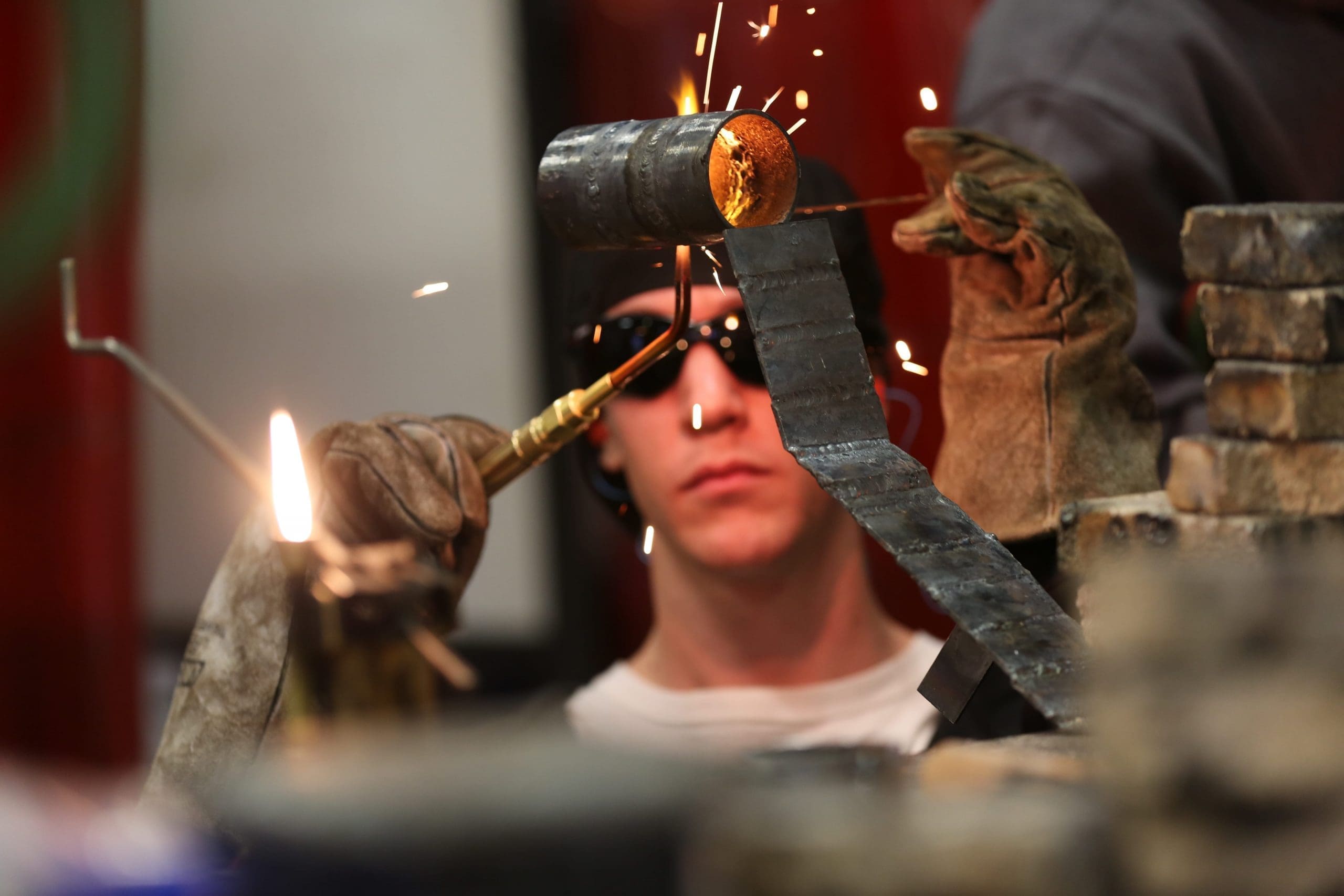Discover the exciting world of welding with this basic guide. Whether you’re gearing up for a comprehensive welding training program or interested in learning more about welding science as a hobby, welding is a fascinating blend of science and hands-on craftsmanship.
Explore the basics of welding, how welding works, common welding tools and how you can receive hands-on welding training at Summit College.
The Purpose of Welding
The basic purpose of welding is to join two elements together with a firm connection. Welders typically work with metal or thermoplastic and use durable filler material to bind them together. Welding is used to create many modern constructions in our world, such as skyscrapers, cars, ships and airplanes.
In the past, builders used other methods of joining metal workpieces. Soldering, brazing and riveting are all alternatives to welding. Learn why welding has become the standard joining option for many industries and why it’s such a highly prized skill in industrial applications and manufacturing.
Welding Basics
Welding works by joining two materials together without a separate binder material. Unlike brazing and soldering, which use a binder that has a lower melting point, welding joins the two workpieces directly together. Understanding this difference is key to understanding welding and why it’s preferred for durable, long-lasting construction.
Common Types of Welding
There are three main welding techniques, so it’s important to understand each option and to know how strong is weld material for your welding applications. Here are the three basic welding techniques available to modern welders:
- Gas welding
- Arc welding
- Laser welding
Arc welding uses an electrical arc to melt work material. First, a grounding wire is attached to the material. Next, the welder places an electrode lead against the work material. As the welder draws the electrode away from the material, it creates an electric arc, otherwise known as an ongoing plasma discharge from the electrical breakdown of gas. Arc welders use either AC or DC power and are used to produce a very concentrated, narrow weld point.
Gas welding is another common welding type. Also known as oxy-fuel welding, it’s an older and more common option. Gas is funneled to a welding stick, or point of focus, and ignited to create a high-temperature flame. It’s best used for high-alloy steels. While the weld point is less concentrated than electric welding, it’s much hotter and more suitable for particularly tough alloys.
Laser welding is the latest innovation in welding technology. This technique is currently only used in large industrial applications. Laser welders use a high-energy beam to fuse materials together. It’s a costly system that requires expert control and finesse.
Become A Welder
Streamlined Learning for Faster Earning
Learn More
Benefits of Welding
Compared to other joining methods, welding offers a number of benefits. Here are just a few reasons why many industrial construction processes weld materials together:
• Durable bond
• Flawless seam
• Superior melting point
• Efficient and versatile system
These benefits make welding a highly sought after skill for automotive, construction and industrial companies. Whether you love working with your hands or are interested in an in-demand, highly paid career, find out if a welding technician is the right career path for you.
“Everything we teach is to prepare you for two things: AWS Certification testing and to receive the necessary skills to get you started in the field of your choice of Structural work or Fabrication work.”
Troy Malinowski, Welding Instructor
The Tools of the Trade
Find out what you need to prepare for a career as a welder. Here are some basic gear and equipment that you need to get started as a welder. Check out all these weld tool options and learn more about the pros and cons of each option.
Before you start up any welder, you need the right safety equipment and location. Welding emits an extreme amount of heat, sparks and metal slag. Protective clothing is essential to protect yourself from burns while working. A welding mask protects your eyes from the bright light of a welder. Extreme temperatures create a light so bright that it can harm your eyes.
The sheer variety of welder tools can be overwhelming. Compare them carefully and use your desired application to find the best welder type for you. If you’re training as a welder, ask your instructor about the best welder for beginners. Here are some common welder types to consider:
• Shielded metal arc welding (SMAW) or stick welding
• Gas metal arc welding (GMAW) or MIG welding
• Submerged arc welding (SAW)
• Gas tungsten arc welding (GTAW) or TIG welding
Your metal and the type of weld you’re hoping to achieve determine the best welder for your purpose. Some welders are better suited for large, structural welds, while others are best for detailed, surface welds that are easy to buff to a flawless finish.
How To Become a Welder
If you’re ready to become a welder, you need to learn how to weld steel safely and effectively. There are many technical skills required to become a welder, so it can be difficult to break into the industry on your own. Join a welding program in California to prepare yourself for an exciting career as a welder.
Summit College has locations across California that train you in the latest technologies of the welding industry. Compare popular Summit trade programs to discover the best option for your interests and career goals. After your training course, you can expect a lucrative and fulfilling career as a welding technician in the construction, automotive, ironwork or factory industries.
Contact us to learn more about our welding program and find out how you can start your journey today. Learn more about the welding process, the latest equipment, our admission process and financial aid for your new course.
Tags: Welding



